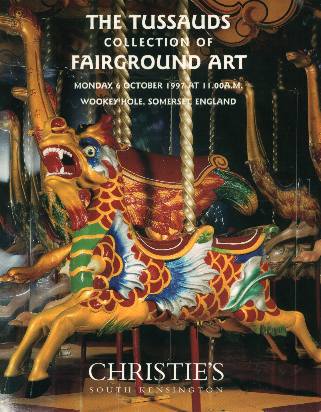Description
1997 Christie's The Tussauds Collection of Fairground Art Wookey Hole 10/6/97. This post auction catalog consists of 295 lots, 99 illustrated, all color, with all lots described in detail.
Once a familiar sight, the fairground Carousel with its ornately carved wooden animals, has become a rarity. Of necessity fibreglass animals have replaced the antique originals, and most of the other old rides and shows have disappeared. Fortunately many splendid examples of decorative fairground work have survived, due to the enthusiasm of far sighted collectors. The Tussauds Collection, recognised as one of the world's finest, was formed during the 1960s and 1970s by Lord and Lady Bangor, whose little shop 'Trad' in the Portobello Road was an Aladdin's Cave of unusual antiques. What the Bangor's couldn't bear to sell they kept, with the aim of establishing a permanent exhibition of fairground art in London. In 1973, The Tussauds Group purchased the bulk of their collection which was subsequently displayed, with much imagination, at one of their former visitor attractions, at Wookey Hole Caves where it is now to be auctioned by Christie's. This wide-ranging collection is without doubt a truly fascinating assemblage with many remarkable pieces, as well as a large quantity of fascinating titbits salvaged fi-om showmen's yards. There are fine examples from all the major British carvers including some delightful rarities hom CJ Spooner's workshops, alongside a superb collection of French pieces and even some highly collectible American figures brought to England for a stage production of the musical, "Carousel", and subsequently rescued by the Bangors. - There are approximately 120 animals and 70 figurative pieces, many of which are extremely rare, some strikingly dramatic, some naive and all carved with the artistic verve which characterises this form of popular art. But is it art? Well I'm sure the great majority of the carvers and painters who produced these beautiful things would not have so dignified their work. They were first and foremost craftsmen producing carved and painted panels to decorate roundabouts, show forms, wagons and organs. Artisans whose directive was to produce images and figures to excite the imagination and part fair goers fi-om their pennies. Except for the lavishly embellished Victorian 'Gin Palace' pubs, the working man had no opportunity of experiencing the sort of opulence offered by the fairground in its heyday. The gilded baroque facades, steam organs and exhilarating rides must have been almost overwhelming. No expense was spared to produce these fairground attractions, and it had the desired effect. The showmen prospered. And yet these artefacts, solely designed as enticements are truly lovely things - examples of Art serving the cause of commerce. The fair has a very long and noble history and whether the main purpose was for the seasonal sale of produce and livestock, or the hiring of agricultural and domestic workers, there were always shows and amusements present. By the second half of the nineteenth century these included large sideshows exhibiting waxworks, fi-eaks and titillating 'art', games of skill or chance, roundabouts (initially revolving 'platform' rides with static mounts), swingboats, helter skelters etc. Later in the century, 'galloper' carousels were developed (with cranks which imparted an up-and-down motion to the roundabout), switchbacks, which pulled gondolas or cars around an undulating track, cakewalks with tilting floors and steam yachts etc. The early twentieth century saw the arrival of the bioscope :... a travelling cinema _ with ornate facade and organ behind which a tented seating area was used for the display of moving pictures, also enlarged faster switchbacks, such as the motor car 'scenics', which were to lead after the Great War, to the huge dragon .arks and Ben-Hur rides. For the most part English and Continental fairground attractions were taken around by travelling showmen, during the warmer months, so everything was designed to be taken apart into components which were small enough to be handled and packed. Many of the American carousels were situated in permanent amusement parks, and this allowed for a greater size and elaboration of the animals. The dispersal of the Tussauds Fairground Art Collection offers a unique opportunity for collectors of Carousel or naive art to enhance their collections, and it also gives scope to interior decorators, designers, film property buyers or enthusiasts to acquire a piece of history which is also an imaginative work of art.
Catalog is in fine condition.


